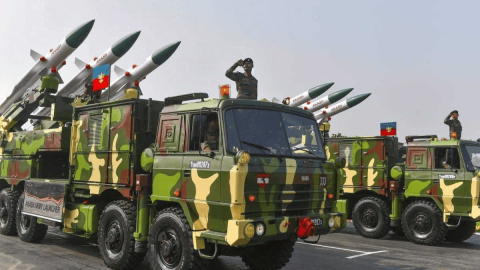India’s Defence Acquisition Council Approves $12.31 Billion for Local Procurement
India’s Defence Acquisition Council has cleared Rs. 1.05 trillion (US $12.31 billion) of fresh capital programmes, all reserved for domestic industry—a decisive stride in New Delhi’s quest for defence self-reliance. The ten approvals span armoured-recovery vehicles, tri-service electronic-warfare suites, next-generation surface-to-air missiles and a cluster of naval mine-warfare assets. Coming on the heels of Rs. 540 billion of March sanctions and a Rs. 627 billion light-helicopter order, the latest tranche lifts total indigenisation commitments above Rs. 2.2 trillion in under twelve months. For investors and strategists alike, the message is clear: India’s “Make in India” doctrine is translating into sustained, high-visibility order flow for local defence manufacturers.
Policy Architecture: Buy (Indian-IDDM) Takes Centre Stage
All ten projects received “Acceptance of Necessity” under the Buy (Indian-IDDM) rubric, the Defence Ministry’s most stringent localisation tier. This requires majority indigenous design, development and manufacture, effectively ring-fencing contracts for domestic prime contractors and their micro-SME supply chains. Defence Minister Rajnath Singh, who chaired the council, reiterated that 75 percent of the FY 2025 capital budget—about Rs. 511,000 crore—is earmarked for domestic sourcing, hard-coding a multi-year revenue runway for Indian industry.
Programme Breakdown: From Battlefield Mobility to Littoral Dominance
- Armoured Recovery Vehicles: Vital for rapid battlefield repair and evacuation of Future Ready Combat Vehicles approved last year.
- Tri-Service EW Systems: Integrated suites to neutralise adversary radar and communications across land, air and sea.
- Surface-to-Air Missile Complex: Indigenous successor to imported quick-reaction platforms, improving layered air defence.
- Naval Mine Warfare Package: Moored mines, mine-counter-measure vessels, submersible autonomous vehicles and super-rapid gun mounts to harden choke points in the Indian Ocean.
- Integrated Inventory Management: AI-enabled logistics backbone designed to reduce spares lead time and improve readiness ratios.
Capital Commitments: A Rolling Wave of Approvals
| Month / Year | Approved Value (Rs., crore) | Key Platforms |
|---|---|---|
| Jul 2025 | 105,000 | EW suites, SAMs, mine-warfare assets |
| Mar 2025 | 54,000 | T-90 engine upgrade, AWACS systems |
| Mar 2025 (CCS) | 62,700 | 156 “Prachand” light combat helicopters |
| Sep 2024 | 170,000 | Future Combat Vehicles, patrol vessels |
Cumulative tally: Over Rs. 2.2 trillion (≈ US $26 billion) of domestic orders in ten months, signalling durable momentum for listed public-sector primes and private tier-one integrators.
Strategic Undercurrents: Deterrence, Diversification, Decoupling
Regional security calculus: Persistent border frictions and an increasingly contested Indo-Pacific encourage New Delhi to sharpen readiness without import dependencies.
Technological sovereignty: Indigenous development reduces exposure to sanctions and supply-chain shocks, a lesson reinforced by global semiconductor and rare-earth disruptions.
Economic multiplier: Defence manufacturing’s high value-added content supports skilled employment, advances dual-use technologies and anchors export ambitions to Southeast Asia and Africa.
Budget Optics: Headroom for Further Allocation
The FY 2025 defence outlay stands at Rs. 681,210 crore—a 9.5 percent year-on-year rise. At 1.9 percent of GDP, India still trails China (≈ 1.7 percent but on a far larger GDP) in ratio terms and the United States (≈ 3.4 percent) in absolute deterrence spending, suggesting political cover for incremental increases in FY 2026.
Investor Impact: Mapping Beneficiaries and Risk
Likely winners: Hindustan Aeronautics, Bharat Electronics, Bharat Dynamics, and emerging private players in electronic warfare and robotics.
Execution risk: Schedule slippages and cost overruns could strain margins; investors should track milestone payments and liquidated-damage clauses.
Input volatility: Dependence on imported avionics chips and specialty alloys remains a margin swing factor until domestic fabs scale.
Actionable Takeaways
- Portfolio Strategy: Consider staggered accumulation of defence OEMs with order-book visibility exceeding 3× FY 24 revenues.
- Supply-Chain Positioning: Mid-cap precision-engineering and software firms enabling EW and AI logistics stand to outgrow headline primes.
- Policy Engagement: Watch for forthcoming Production-Linked Incentive tranches covering drone swarms, directed energy and hypersonics.
A Year of Reform Gains Financial Muscle
Labelled by the Defence Ministry as the “Year of Reform,” 2025 is translating bureaucratic rhetoric into hard rupee orders. By binding capital programmes to the Buy (Indian-IDDM) category, New Delhi is not merely nudging but mandating supply-chain localisation. For India’s armed forces, the acquisitions promise better mobility, resilient logistics and maritime denial capabilities. For domestic industry and capital markets, they offer a visible, multi-year earnings catalyst—tempered only by the perennial execution risks inherent in complex weapons programmes. The trajectory is set: India’s defence modernisation will be built—and increasingly financed—at home.
